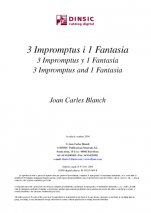3 Impromptus and 1 Fantasia

Num Pàgines Interiors
Continguts generals
The three 'impromptus' have a common theme: they all use a series. The series from the first and second are the same with 37 notes each, and the third one has 38 notes. The feature of the three 'impromptus', as well as the fantasia, is the counterpoint, especially the imitative. In the first two, there is practically no rest time, and achieves the maximum tension in a climactic point, which progressively decreases (the second one is more uniform). The first one begins with a brief introduction in which the series is presented, and it conducts practically the whole piece. The second takes some importance from the series, and it uses it to develop the hold of the first measure, which is formed by four notes: Fa, Mib, Do, Fa, played with the left hand. We will see that this pattern appears at different times as an inversion as well as with mutations.The third one, though structurally-speaking less complicated, is more complex rhythmically, and lets us glimpse a change in the way of treating and developing the material. The technique used does not (at any moment) have anything in common with the dodecaphonic technique.
The fantasia, which follows the three 'impromptus', and has a more extroverted character, is the first one to break with the use of material in a series form to get a thematic material which is developed through sections or blocks.
Harmonically, the four pieces have a high degree of homogeneity, thanks to the fact that they always use just two unique music chords of four notes each, transported to the twelve half steps of the chromatic scale and with no apparent relation to the tonal music chords. We can't talk about harmonic functions in a tonal way, but we can do it with climactic points of tension and of distention.
Instruments
PianoCaracterístiques tècniques
Mides
21 x 29,7 cm, vertical
Nombre de pàgines
31
ISMN
M-69210-089-8
Editor
DINSIC Publicacions Musicals









